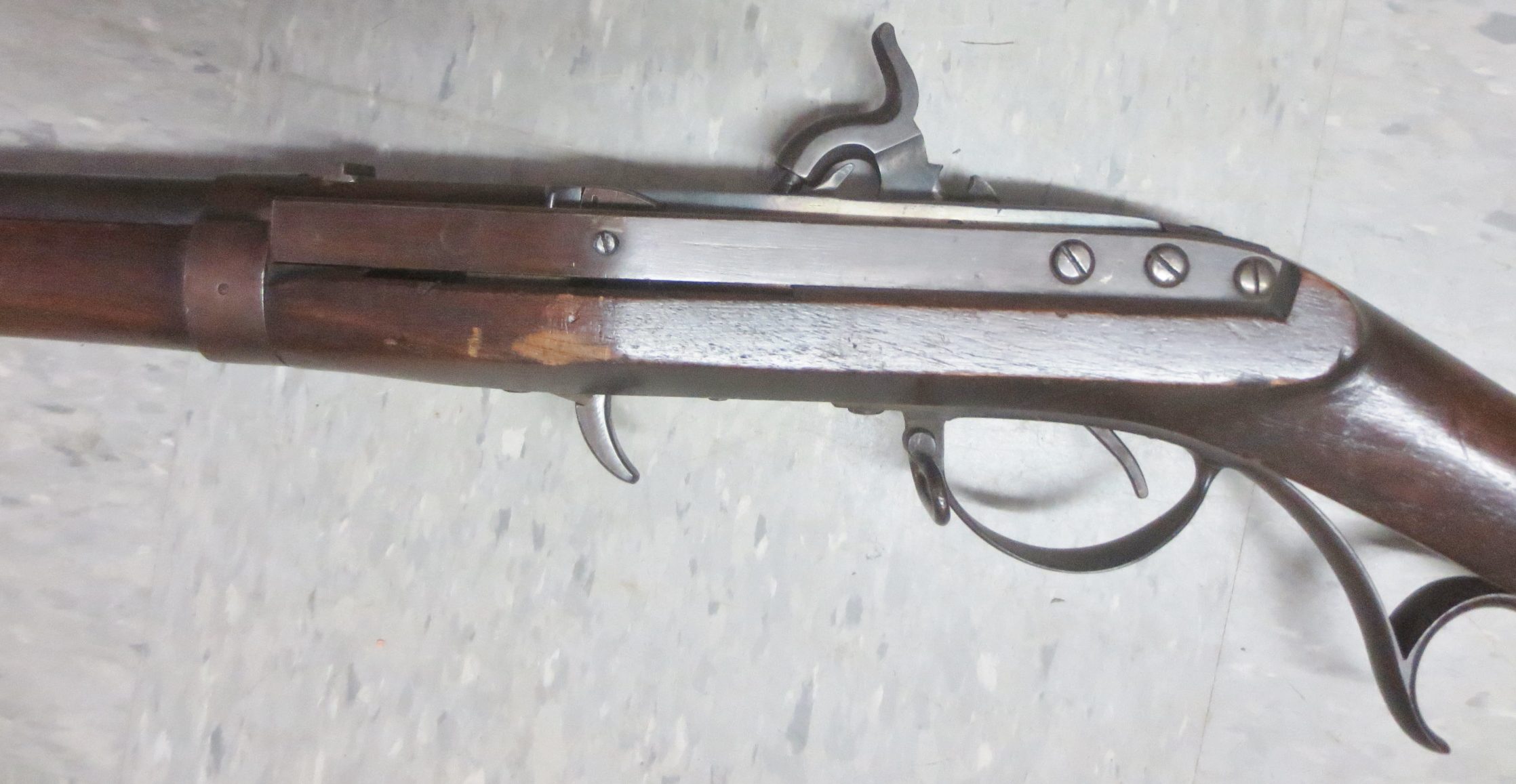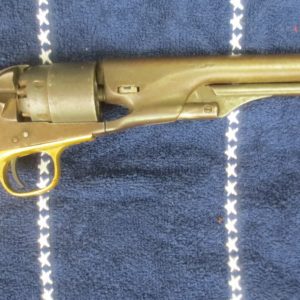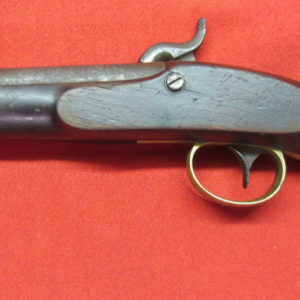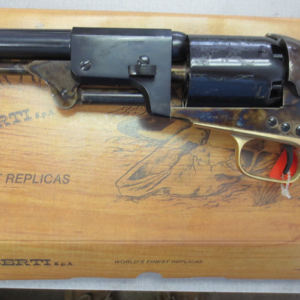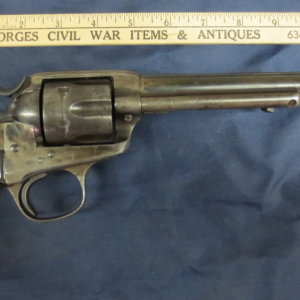Description
On January 10, 1817, the US Ordnance Department madea radical and unprecedented decision by agreeing to purchase one hundred Hall’s Patent Breechloading rifles from their designer, John H. Hall. Hall had received his patent for a breechloading flintlock rifle on May 21, 1811 and had been producing small numbers of rifles in the Portland (District of Maine), MA area. The “District of Maine” was a territory considered part of the state of Massachusetts and would not become a separate state until 1820. The rifle used a tilting breech block that contained the center mounted flintlock battery and the chamber that was loaded with a charge and ball. By pressing a lever under the rifle, the front of the block could be tilted upward allowing powder and ball to be loaded, and then pressed down again, aligning the chamber with the barrel. The pan was then primed, and the rifle was fired in the usual manner. By 1814, at the height of the War of 1812, Hall had succeeded in receiving an inquiry from the Ordnance Department regarding his design but Hall demurred, stating that the inability to keep a regular workforce at that time (no doubt due to the exigencies of war) prevented him from entering into a production arrangement. By 1816, following the end of the war, Hall’s situation had changed and again he pursued a military contract. His persistency and tenacity paid off and as a result, an initial order for one hundred of his breechloading flintlock rifles was received. The guns were to be delivered complete with bayonet and appendages (tools and bullet mold) for a total price of $25.00 each. Hall must have had a number of parts available on hand (or even a number of completed rifles) as he contacted the Ordnance Department in August to announce that the guns were ready and to inquire as to where they should be delivered. From early correspondence with Hall, it seems that while the ever-cautious Ordnance Department was intrigued with the breech loading design, they were hesitant to adopt it without thorough testing. They also seemed to develop early concerns about the potential cost issues of adopting a rifle for widespread issue that utilized a patent held by a private citizen. Some documents suggest that prior to the initial contract, there were already discussions within the Ordnance Department about somehow producing the rifle at a government facility (rather than a private one), with some type of flat (or reduced) payment to Hall to cover the use of his patent.
In order to obtain real world feedback regarding their use, the first one hundred rifles were ordered to be delivered to Boston initially, from which they were shipped to Baltimore, then Pittsburgh and finally to St. Louis. From St. Louis, ninety-eight of the Hall’s Patent Rifles were issued to a regiment of riflemen stationed at Bellefontaine (about 25 miles away) with two of the rifles being held by the Ordnance Department as samples. These first production rifles had 34” octagonal barrels, turned round at the muzzle to accept a socket bayonet and were .52 caliber. The barrels were pinned to the stock which was mounted with brass furniture, including a four-piece patchbox and three ramrod (wiping rod) pipes. In a report from Colonel Talbot Chambers of the riflemen, dated March 22, 1819, it was reported that the rifles tended to foul making loading difficult and that they often “hang fired”. The Colonel dismissed the rifles as essentially worthless and did not recommend their use or general acceptance. His report, however, was somewhat late as John Hall had already moved his operation to the National Armory at Harpers Ferry and was in the process of establishing the soon to be famous rifle works at that location. During most of 1818, John Hall worked at Harpers Ferry producing several sample breechloading rifles and testing. By the end of the year it was determined that his system was certainly superior to the current issue muzzleloading arms in terms of ease and speed of loading and was at least equal to the standard issue arms in terms of accuracy and durability. As a result of these tests, it was determined that the rifle of Hall’s design should be put into production at Harpers Ferry but that for the time being the traditional muzzleloading musket would remain the standard issue infantry weapon. By the beginning of 1819, Hall was supervising the construction and acquisition of machinery to produce his patent rifle at the new Rifle Works at Harpers Ferry. The most revolutionary component of the new facility was that the rifles were to be manufactured on the principle of interchangeable parts. This would be somewhat more difficult than either Hall or the others at Harpers Ferry had initially envisioned and it would be five years from the time that construction began until the first 1,000 US Model 1819 Hall Rifles would be completed in 1824. The “production version” of the rifle had a 32 5/8” round barrel that was secured by three barrel bands that were secured by band springs. The furniture was of iron, rather than brass, and the iron parts were lacquer browned, while the breechblock and hammer were case hardened. The rifle remained .52 caliber, with a .535” chamber in the breechblock and had narrow, 16 groove rifling. The first 1 ½” of the barrel were left smooth (and about .54 caliber) to protect the rifling. While it has been suggested for years that this area of smoothbore at the muzzle was similar to the false muzzle used on a muzzle loading target rifle to help protect the rifling from damage during loading, Peter Schmidt (author of Hall’s Patent Breechloaders) suggests this makes no sense. As the bore diameter of the rifle was smaller than the chamber, it would be almost impossible to load a .535” round ball through a .52” bore without a hammer, a strong rod, and severe deformation of the ball. More realistically, it appears this area was intended to help protect the rifling from damage inherent from regular mounting and dismounting of a bayonet, and potential damage during bayonet drill. The initial reception of the Hall Rifle was positive enough that a second order for 1,000 was rifles was placed by the Ordnance Department. These rifles showed some very minor changes to the cock and pan fence over the first 1,000 but were otherwise the same as the first 1,000 and were delivered between 1825 and 1827. In March of 1827, a new order for 3,000 rifles was placed with Hall at the Rifle Works, and the following year another 6,000 rifles were ordered. These “2nd Production” Rifles from what Schmidt refers to as the 2nd & 3rd contracts, were delivered between 1832 and 1834. The largest change (or improvement) found in these guns over their predecessors is the change from the use of band springs to secure to the barrel bands to the use of longitudinal pins to secure the bands. The only other change was an attempt to further standardize the screws used in the production of the guns, and while the size of the screw and the number of threads was already standardized, it appears that the pitch of the threads was not, and this meant that sometimes the screws would not interchange as they should. The 2nd Production rifles featured fully interchangeable screws, as well as all other parts. During the time that the first 11,000 rifles were produced the “Rifle Works” had operated in a sort of strange limbo of being a public-private partnership. It was not really an official part of the Harpers Ferry Armory and had actually been excluded from drawing supplies and stores from the main arsenal. Hall was a civilian employee with an annual salary and was paid an additional $1 per rifle royalty. The rifles were contracted and paid for by the government, but Hall had to operate the facility out of the income from the sale of the rifles to the government and cover all expenses, including payroll from these payments. Hall consistently ran over budget at the facility and was often hard pressed to pay his employees. In the fall of 1834, the status of the Rifle Works was officially changed, making it part of the Harpers Ferry Arsenal system and Hall was re-designated as the Master Armorer of the Rifle Works. At this time as well, an 1834 dated order for 4,000 Hall Rifles (aka “3rd Production Rifles”) was increased to 5,000. These rifles would be delivered between 1837 and 1838. The final batch of Hall flintlock rifles was produced and delivered between 1840 and 1841. The primary difference between the 2nd and 3rd production rifles were the inclusion of “protectors” in the 3rd production rifles. These were metal blocks added to the breechblock supporters that helped to absorb and distribute recoil. The other minor change was an increase in the size of the gas port slits in the frame of the rifle, extending them from 4” to 4.45” in length and widening them from .1” to .175” in width. John Hall would remain at the Rifle Works nearly to the end of production of the US Model 1819 Rifle but was forced to request a medical leave in January of 1840 due to failing health. Hall never returned to Harpers Ferry and died in February of 1841. The production of the Hall flintlock rifle ended at about the same time as Hall’s death, and no flintlock rifles were delivered from Harpers Ferry after 1841, although some 4,200 percussion Hall Rifles were made up during 1841 and 1842.
Initially, the Hall Rifle was intended only for issue to specialty troops, as the standard US military long arm for the infantry was the smoothbore musket and rifles were not regularly issued. It was subsequently decided that the rifles could be issued to the “Light Companies” of infantry regiments, those who were often called upon for skirmish duty and were usually the flank companies in a line of battle. By April of 1832, it was decided to arm the majority of the 6th US Infantry with Hall Rifle, and they used them quite effectively during the Black Hawk War that year. The Hall Rifle was particularly popular with southern state militias, with nearly 2,500 being issued to the various states under the Militia Act of 1808 during 1836 alone. During the Seminole Wars the rifles proved to be extremely popular with state troops fighting in the Florida swamps and some of the rifles even saw service during the Mexican American War with Tennessee volunteer troops, the Rochester Union Grays of New York (as part of the 10th US Infantry) and the Missouri Mounted Volunteers in Santa Fe. Even though the Hall was issued in some quantity and was popular with state troops, it did have its detractors and some design issues. Many soldiers found the fact that gas often leaked from the seam between the breechblock and barrel to be somewhat troublesome. This had to be both distracting and potentially hazardous. As the rifle saw more and more use, the face of the breechblock and breech would experience some erosion for the hot gas, which only increased the gap and allowed more leakage. The gas leakage was a well-known design issue and it was for that reason that gas escape ports were originally incorporated into the frame of the rifle, to help reduce stock erosion. These ports were even enlarged during the last major production run of the rifles, to allow more gas to escape from the sides, rather than burning the interior of the stock. At the outbreak of the Civil War, large numbers of Hall Rifles were in southern state arsenals, and many were subsequently altered to percussion for use by Confederate soldiers. Some Hall rifles ended up having a service life of nearly four decades, as some of the guns originally produced during the 1820s saw service again in percussion form during the 1860s.
This example is a VERY FINE condition 2nd production type US Model 1819 Hall Rifle (4th Contract) which has been arsenal converted to percussion ignition. The breechblock is marked in four lines:
J.H. HALL
H. FERRY
U S
1834
This 1834 dated Hall rifle remains in really wonderful and crisp overall condition. The breechblock locks tightly and securely into positions and the hammer locks crisply into both the half cock and full cock positions. The breechblock has a lovely mottled dark gray with charcoal blue appearance, retaining some of the original dark case colored patterning which has faded and dulled. The interior of the block shows some original coloration. The case hardened breeches of these rifles are not normally known for the vivid colors often found on other 19th century firearms and as with most Halls it has the typical muted dark gray coloration, even though it retains much of the original finish. The barrel of the rifle retains about 70%+ of the original arsenal applied lacquer brown finish, with some thinning and wear, mostly minor scrapes from handling, storage and use. The majority of the finish loss is scattered along the top of the barrel, and along the high edges and contact points. The exposed metal where the finish has been worn off has a medium steel gray patina. The barrel of the rifle is almost entirely smooth with some only light scattered pinpricking present. The rifled bore is in VERY FINE to NEAR EXCELLENT condition with fine, sharp rifling present. As is typical of all Hall rifles, the first 1 ½” of the bore is smooth, allowing bayonet use without the potential for damaging the rifling. The triggerguard, barrel bands, buttplate and other furniture all retain about 60%+ of their original lacquer browned finish, with the exposed metal having taken on a medium dark pewter gray brown patina. The original offset front sight and bayonet lug is in place at the end of the barrel and the matching offset rear sight is in place at the rear of the barrel as well. The original button head “ramrod” (cleaning rod) is in place in the channel under the barrel. It is full length and retains fine threads at the end. The stock is in EXCELLENT condition and retains sharp edges with crisp lines and flats. As would be expected, the stock shows the usual handful of minor bumps, dings and bruises from service, use and storage, but absolutely no abuse. One scuff on the left side appears to be relatively recent, but no significant damage is noted.
Overall, this is a really outstanding example of a US M-1819 Hall Rifle. The gun is 100% correct and original, retains the large majority of its original finish and has a truly exceptional stock. In addition, it is accompanied by an original M1819 Hall socket bayonet, which is more difficult to obtain than the weapon itself.



